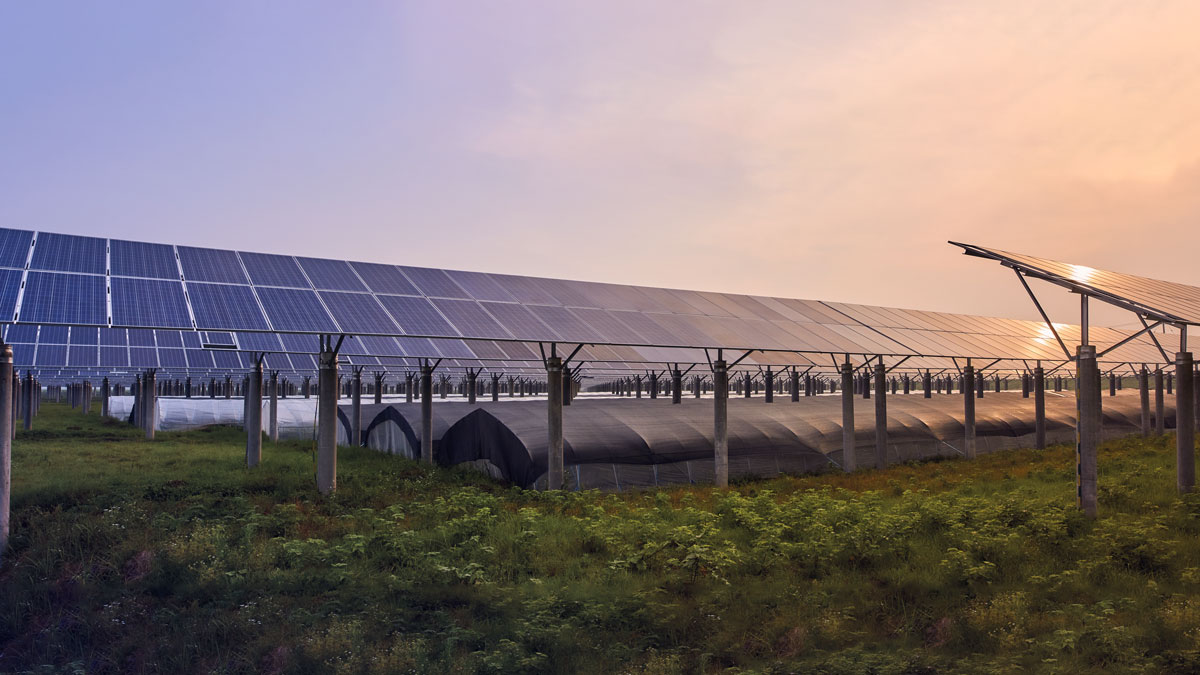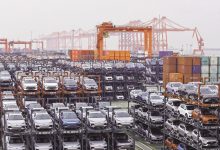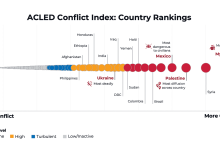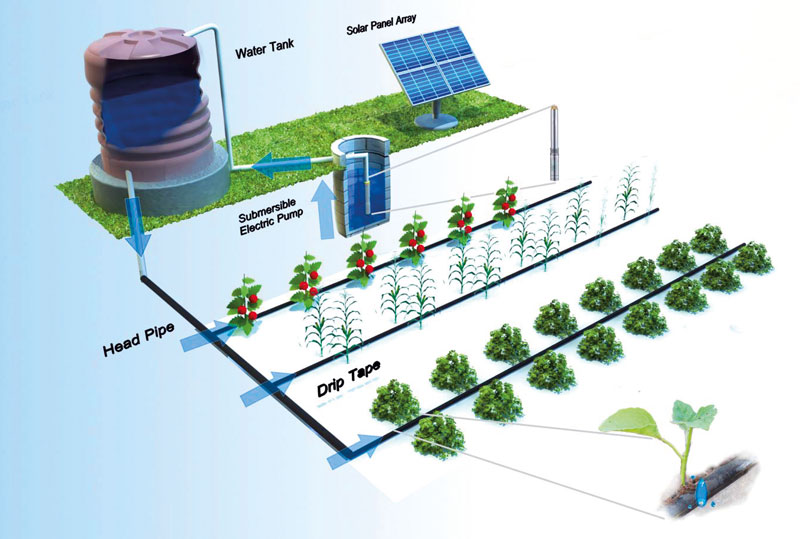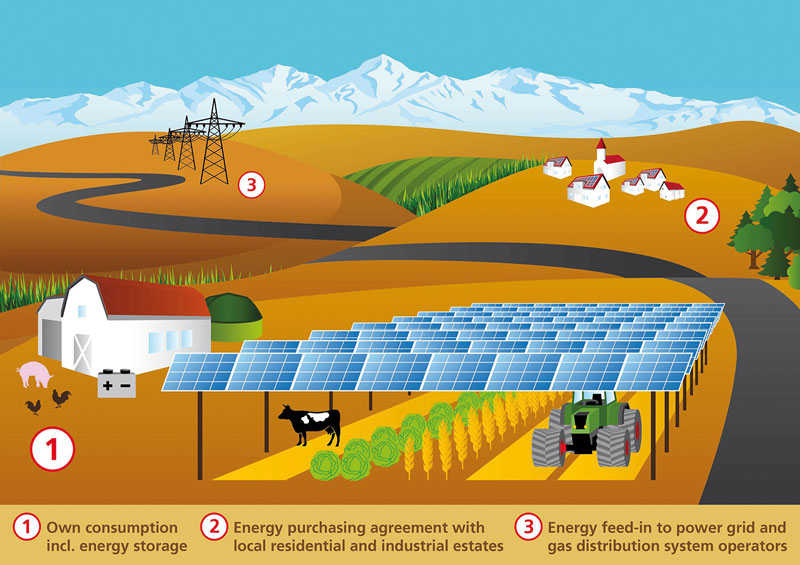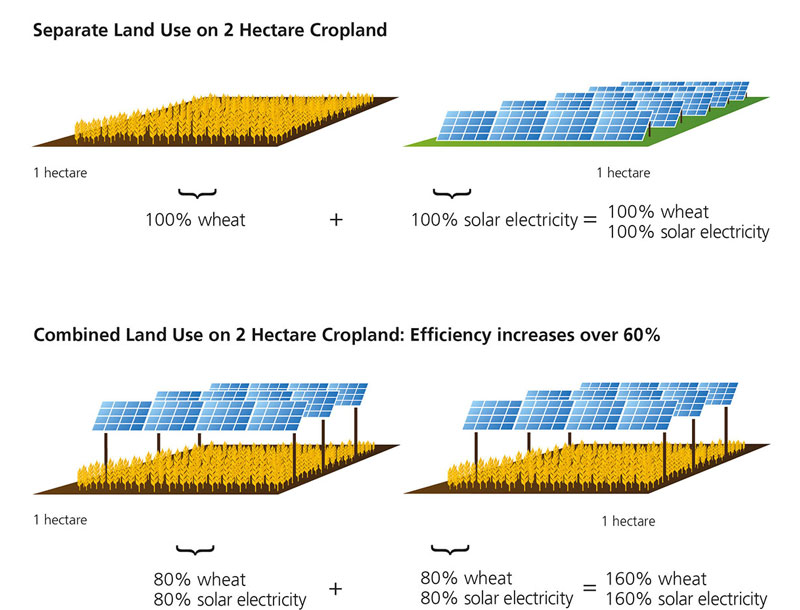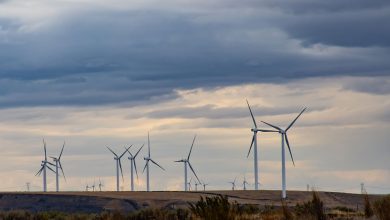Agrivoltaic Systems, A Promising Experience
The agrivoltaic system is characterized by combined production of photovoltaic power and agricultural crops on the same area. Coexistence of solar panels and crops involves light sharing so that panels placed above part of the crop generate shade and create a kind of microclimate over the growing area. The result: more freshness, so less water requirement for the plants, but also lower losses caused by evaporation.
Initially, association of solar panels over agricultural crops aimed at providing a good ratio between the use of arable land and production of photovoltaic power. To compare the performance of association of these two different elements, LER (Land Equivalent Ratio) is used. LER is the unit of measurement and a LER higher than 1 indicates that the combination works better than it would work separately. For example, a LER of 1.3 means that in order to obtain the same production on two separate areas, 30% more area is needed. Cohabitation between agricultural crops and photovoltaic power production would make possible to obtain a LER higher than 1 and, therefore, improve the total production on the equipped area.
In recent years, developers of agrivoltaic solutions have highlighted the benefits for farmers, especially protection against risks and climate disruptions. Another benefit is protection against extreme temperatures (frost or heat wave): in greenhouses with or without temperature control, with or without bleaching; in open field with a reduction in temperature amplitudes due to shading in the event of high temperatures or a greenhouse effect in the event of frost. The system also provides hail protection: in closed greenhouses with roof; in open field with arrangement systems or the deployment of automatic safety nets integrated in the structure. Other advantages include the reduction of water consumption by reducing plant evapotranspiration due to crop shading and increase in agricultural yields. Another benefit is irrigation with solar power.
Even in absence of irrigation needs (in case of very rainy season), solar panels produce energy, therefore opening significant opportunities to power with this energy agricultural equipment, mills, water purifiers and cold storage units, all contributing to rural development and increased revenues. In some cases, solar power can also become a ‘remunerative harvest’ if farmers are encouraged to reduce the excessive water quantity, opting to sell the energy surplus in the power grid.
Photovoltaic greenhouses, controversies
The main risk of these devices refers to lack of light for plants and decreased agricultural production. Photovoltaic greenhouses have created a lively controversy in the agricultural world. Depending on technical itineraries or the type of crop, agricultural yields in photovoltaic greenhouses can be much reduced. Therefore, crops in photovoltaic greenhouses require an adaptation of cultivation practices, and producers are trying to adapt these tools to farmers’ needs. Some photovoltaic greenhouses also suspected of being only pretexts for installing solar power plants on agricultural land. In Japan, to allow them to operate solar panels over crops, the Japanese legislation requires farmers to maintain agricultural production above 80% of what they produced before the panels were installed.
Shaded devices can also bring increased humidity and increased risk of developing diseases or pests. Wind can also be a danger of fall for systems in open field, with solar panels built several meters above ground.
When designing and building an agrivoltaic plant, account should be taken of the agricultural activity and its requirements. Soil compaction and changes in water circulation can degrade the quality of agricultural land. Installation of solar panels should consider the size, width and radius of rotation of agricultural equipment used for crop maintenance, the provision and protection of external cables, and the depth of buried cables, including the presence of personnel, agricultural machinery or animals.
Visual impact on the landscape is also mentioned by the opponents of agrivoltaic systems: solar panels are generally installed several meters above ground and, therefore, are very visible in the landscape.
In case of perennial structures or for long-term commitments (more than five years), the financial power of the photovoltaic company can be a risk the farmer if the photovoltaic producer has committed to disassembly the structure. It should operate the mobile solar panels and if it is no longer able to meet its commitments the farmer can find part of its land immobilized with a system that no longer brings profit or even affects the agricultural production.
Advantages of the use of a solar power irrigation system
The advantages of choosing a solar power irrigation system include:
- Very low operating costs
- Green
- Solar power is absolutely free of charge, as compared to non-renewable energy sources such as gas, diesel or commercial power grid
- No infrastructure is required
- Use of solar power provides the possibility of installing an irrigation system wherever the water source and solar light are located, no matter the availability of the commercial power infrastructure
- Does not require fuels that emit harmful substances (CO2), which can contribute to the additional pollution of the environment and noise pollution, compared to traditional irrigation systems that use diesel or gasoline
- Accessibility and sustainability
- Solar power is completely renewable and accessible
- Safety
- Duration of operation of solar panels is approximately 25 years
- Time saving
A solar power irrigation system allows an automated activity, without physical involvement of the farmer, who has real-time access to information on soil humidity and air temperature, can switch on and off the irrigation process remotely, due to necessary software and hardware implemented in the project
- Additional income source
Solar panels produce energy even when irrigation is not necessary, therefore opening up significant opportunities to supply with electricity other agricultural machinery, mills, water purifiers and cooling units, all contributing to rural development and additional income
- Increased value of property
Studies show that properties that have installed solar-powered irrigation systems increase their resale value and become more attractive to buyers.
Although, now, adapted drip irrigation can lead to water saving, the assumption that it will be applied automatically at the level of each farm is an error. Irrigation policy decisions should be made after adequately accounting for water on extended areas, as precipitation, surface water, groundwater, soil humidity and evaporation processes related to various land uses are part of the same hydrological cycle. Modern solar power systems provide useful tools to improve water management, with the electronic control devices able to provide real-time data on storage reservoir levels, pump speed and groundwater level in the drilling area, which could lead to remote adjustment decisions to prevent excessive use. A viable alternative is to set water tariffs in relation to supply and demand calculations determined by satellite and thermal imaging, a technique facilitated even at the level of individual fields by the FAO Open Access Portal for Water Productivity (WaPor).
However, the real benefits of these systems haven’t been fully validated, mainly due to the lack of long-term studies on representative surfaces. Developers of agrivoltaic systems conduct few studies on the agronomic performance of their products or do not communicate them. Studies conducted by independent organizations were made mainly on photovoltaic greenhouses.
A survey by technical experts from 25 countries suggests that while three-quarters of states have government programs and policies to promote small-scale irrigation, less than half have specific regulations that limit groundwater abstraction for such purposes.
As one of the objectives of agrivoltaic systems is to preserve agricultural land, this is all the more reason not to neglect agrivoltaic agricultural production. But constraints on agricultural production vary from one country to another in accordance with the legislation in force or depending on the type of crop and the objectives of the agrivoltaic system.
Configuration of agrivoltaic devices
Regarding the types of configuration of agrivoltaic devices, since 1980, German physicists Goetzberger and Zastrow studied the conditions for optimizing agrivoltaic plants. Therefore, the conditions that continue to serve as reference in the definition of agrivoltaic systems are: orientation of solar panels to the south for fixed panels or east-west for panels that rotate on an axis; sufficient spacing between the solar panels for sufficient light transmission to the ground crops; raising the supporting structure of the solar panels to homogenize the amounts of radiation on the ground.
The basic components of a solar powered irrigation system are:
- Solar panels – take solar radiation and turn it into electricity
- Electric pump – depending on water source (groundwater as well as open water sources, such as nearby rivers and lakes), there are two types of pumps: surface pump – is installed right next to the water source and has as components two pipes, for water absorption and discharge; submersible pump – is installed or immersed in boreholes or deep wells
- Filter – the tool for cleaning water of physical impurities (sand, shells, stones, plant debris)
- Fertigation node – the tool for injecting fertilizers into the water for irrigation
- Reservoir – is an optional component, which may be needed to store water that has been pumped during the day and can be used in a drip irrigation system
- Water supply pipes (main, secondary and drip pipes)
History of agrivoltaic systems and journey around the world in the last 25 years
Proposed in 1981, the agrivoltaic system was massively implemented in Japan since 2004 and ever since it has developed throughout Asia, Europe following. In Austria and then in Italy, agrivoltaic systems appeared in open fields in 2007, and in the period 2009-2011 their implementation followed in France and Germany.
Austria
In 2004, Günter Czaloun provided a system of suspended mobile solar panels powered by cables. The first prototype was built in South Tyrol in 2007 on a 0.1 ha area. The panels are more than five meters above the surface. A new system was presented at the Intersolar 2017 conference in Munich. This technology may potentially be less expensive than other open field systems because it requires less steel.
Italy
In 2009 and 2011, vineyards were equipped with an agrivoltaic system with fixed panels. Experiments showed a slight decrease of the yield and late harvests.
In 2009 the Italian company REM TEC developed a dual-axis solar tracking system. In 2011 and 2012, REM TEC built several MW of open field agrivoltaic power plants. These were the first open field agrivoltaic power plants in Europe. The solar panels are installed 5m above ground to operate agricultural machinery. The occupation rate of solar panels is less than 15% so as not to disadvantage crops. These are the first to offer automatic protective net systems, integrated in the support structure. REM TEC also designs mobile solar panel systems installed above an agricultural greenhouse and integrated into the structure of the greenhouse. Controlling the position of the panels would optimize the greenhouse microclimate.
Germany
In 2011 the Fraunhofer Institute ISE launched the concept in Germany under the ‘agrivoltaics’ name. Developments accelerate with the APV-Resola project started in 2015 and which ended in 2020. A first prototype of 194.4 kWp was to be built in 2016 on a 0.5 ha site belonging to the Hofgemeinschaft Heggelbach cooperative farm in Herdwangen (Baden-Württemberg). Germans estimate that such structures will be profitable without government assistance as of 2022.
Croatia
In 2017 a structure was installed by Work-ing d.o.o. with a 500 kWp open field power plant in Virovitica-Podravina region. The agronomic component of this power plant is supported by the University of Osijek and the Agricultural Engineering School of Slatina. Part of electricity produced is used for the irrigation system and to operate agricultural machinery. At first crops requiring shade will be tested under the device.
Netherlands
In 2019, photovoltaic developer Solarcentury signed an agreement for the construction and maintenance of the largest agrivoltaic park in Europe. The park covers 24 ha of cranberry crops.
France
Since the beginning of the 2000s, several companies have implemented photovoltaic greenhouse projects on the French territory. Several types of greenhouses were built, with various architectures and solar panel plans. Designers of photovoltaic greenhouses continue to innovate to improve both agricultural production and electricity production. The Agrinergie concept developed by Akuo Energy (2007) is an illustration of this fact. The first plants consisted of alternation of crops and solar panels. In 2017, Tenergie started building photovoltaic greenhouses with an architecture that diffuses light to reduce the contrasts between light bands and shade bands created by solar panels.
The three-actor system: in this model, the agrivoltaic system, a tool for crop protection, is a partnership between a farmer and a photovoltaic producer. The third actor, independent of the first two, controls the panels, according to the algorithms. The control of the panels is always done with priority for the benefit of power plants and, secondly, for energy production. The priority of agricultural production over energy production is guaranteed by this third actor. However, this model requires success in CRE calls for tenders to obtain a purchase price for energy production.
In Romania, low renewable energy target
Currently, in Romania there is no coherent support system for the installation of new renewable capacities to support reaching the 30% target assumed for 2030, shows the most recent analysis by Bankwatch. The report analyzes the renewable energy sector in Romania, mainly legislative changes, and calls on stability and predictability for sector development. Limiting the support scheme through green certificates to installations commissioned by 2016, without replacing it with other incentives (direct bilateral contracts or contracts for difference) has led to the stagnation of the installed capacity of renewable energy forms. At the same time, the often-legislative changes, four in seven years, have led to the prejudice of producers and the decrease of investor confidence. Therefore, during 2016-2020 no new renewable energy projects were inaugurated, although in recent years costs with investments in these technologies have fallen. Romania has installed the same renewable energy capacity since 2015: 10,700 MW, of which 4,800 MW are subject to the green certificate scheme.
The analysis also shows that the renewable energy target assumed by Romania for 2030 is lower than that achieved in the period 2007-2020 (from 16.4% to 24%), although European sources of funding available are more consistent, and the cost of installing renewable technologies is lower compared to the previous period. At the same time, the fact that Romania has reached the renewable energy target for 2020 since 2015 shows that our country has a substantial renewable potential that will remain untapped. Another problem identified is the inconsistency of strategic documents. The National Energy and Climate Plan provides for an installed capacity by 3,700 MW higher for wind and solar in 2030, compared to the power transmission grid development plan prepared by Transelectrica.
Eppur si muove (And yet it moves)…
However, there are also innovative projects in Romania, which provide the perspective of good understanding of transformations that we cannot bypass. The University of Agricultural Sciences and Veterinary Medicine (USAMV) in Cluj-Napoca has been involved in testing a technology based on field sensors powered by solar energy.
The project ‘Solarvibes – Revolutionizing IoT Scalability in Agriculture’ is a cascade grant Internet of Food & Farm 2020 (IoF2020)’ for research and innovation, being implemented in the field of ‘Arable land’, between 01.01.2019 – 30.04.2020, in a consortium consisting of: Solarvibes Berlin (coordinator of consortium and partner), Institute Fraunhofer for Reliability and Microintegration IZM of Munich (partner), USAMV Cluj-Napoca (partner) and Hungarian Research Institute of Organic Agriculture, Budapest (partner). The total budget is EUR 600,000. ‘Internet of Food & Farm 2020 (IoF2020)’ is a Horizon 2020 project, Research and Innovation section, IOT-01-2016 axis, applied and coordinated by Wageningen University & Research, in a consortium with over 70 partners from 14 European countries, in the period 2017-2021. This international project aims to accelerate the use of Internet of Things (IoT) technologies in the food industry and European farms.
A group of sensors powered by solar energy is placed on the agrisensor/multisensor equipment, which collects data for the artificial intelligence module. It can develop agro-technical recommendations specific to geo-climatic conditions to achieve optimal levels of yield, by mitigating the risks related to the farmer’s decisions regarding the time of sowing, nutrient management or harvesting. USAMV Cluj-Napoca allocates approximately 100 devices to Romanian farmers through its network of partner farms, free of charge in the first year of implementation. A few pilot farms will be chosen in the next period to implement the technology free of charge for a period of one year, after which it will be accessible at subsidized prices to all farmers.
USAMV Cluj-Napoca undertakes innovation and research tasks that lead to implementable results, through which it guarantees the sustainable development of agriculture and food production in Romania. To this end, the university develops professional networks of cooperation with research institutes and farmers, carries out research and information activities and provides technical advice to those interested.
Digital technology will facilitate a more efficient decision-making process, without replacing the need for human intelligence in agriculture, and will facilitate the work, therefore making agriculture more attractive for young people. Moreover, in the future, in agricultural support systems, it is expected to pay special attention to digital technologies to improve the competitive advantage and sustainability of agriculture.
Irrigation systems powered with solar energy
Irrigation systems powered with solar energy are now an affordable and environmentally friendly technology for both large and small farmers in developing countries. But they need to be properly managed and regulated to avoid the risk of using water in an unsustainable manner, reads a new report by F.A.O. – Food and Agriculture Organization of the United Nations. Sudden and constant decrease in the price of photovoltaic panels provides a new boost to use the renewable energy source to increase the irrigation capacity.
Solar-powered irrigation systems provides the possibility to reduce GHG emissions per unit of energy used to pump water by more than 95% compared to the alternatives powered with electricity generated by burning diesel or fossil fuels, according to FAO report. Assessing the economic viability of a solar-powered irrigation system requires an analysis of a wide range of parameters, such as system size and configuration, water storage capacity and feasibility, well depth, distance to the area to be irrigated and the type of soil to be irrigated. The so-called ‘payback periods’ for such investments depend on crop and market conditions, as well as the presence of price incentives from governments. Solar pumps for irrigation could also cause unsustainable extraction of groundwater, as farmers could try to extend the planted areas or move to crops with higher water consumption. An issue in the field of irrigation currently faced by farmers is the location of the agricultural land in remote areas, without connection to the power grid or connection to the grid may be way too expensive.
In this case, several solutions are available: motor pump (gasoline, diesel); generator for electric pump (gasoline, diesel); route of connection to the commercial electrical network etc.
A solution could be solar energy – combination of photovoltaic systems with surface or submersible pumps to distribute water directly from the source or accumulation in a reservoir. In case of daytime systems (operating without a battery, the system only works during the day) the efficiency can be increased by using the energy accumulator connected to the photovoltaic panels. This option is a smart investment, which although initially seems expensive, is in fact very advantageous in the long run, compared to traditional diesel and gasoline irrigation systems, which are cheaper to purchase, but expensive in operation and dangerous for the environment.
Agrivoltaics – an essential part of the European Green Deal
Agrivoltaics shows a new approach to exploiting Europe’s energy potential from offshore renewable sources, in a sustainable and inclusive manner. This is an essential part of the European Green Deal and the EU’s recovery package, Next Generation EU, which will help create jobs and boost investment as new clean technologies are implemented across the EU. Strengthening domestic energy production will contribute to affordable energy supply and boost the resilience and security of Europe’s energy supply.


